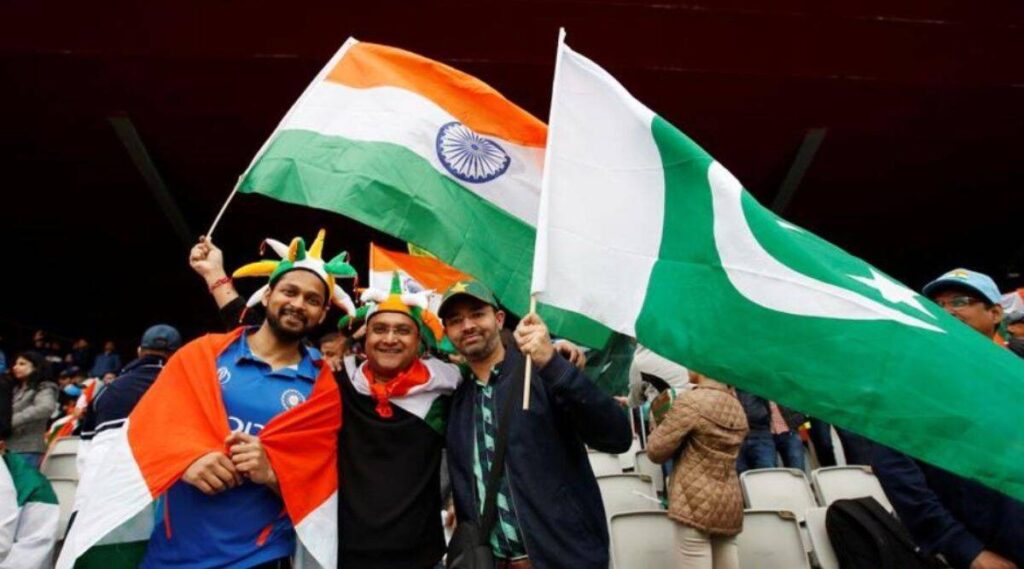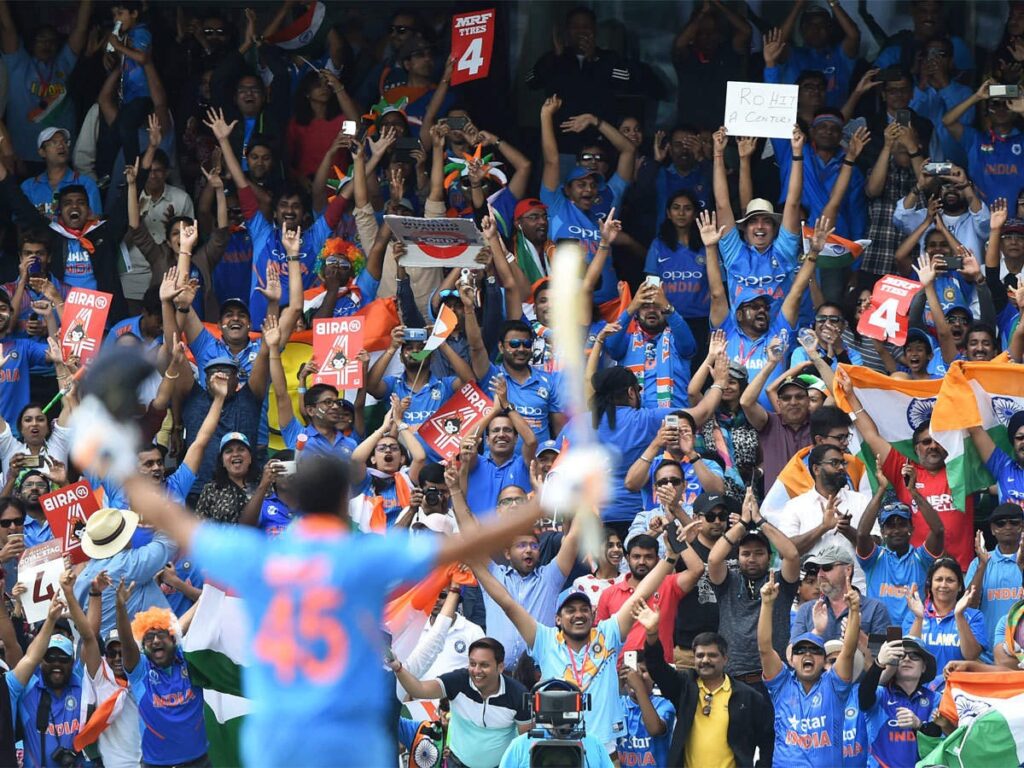
It was the India-Pakistan encounter at the 2019 World Cup, and I was in Manchester a couple of days ahead of the match to soak in the atmosphere and build up to the game. Curry Mile, the desi hub in Manchester, was all decked up. New items on the menu in almost all of the restaurants, to multiple events with cricket stars for the thousands who had trooped into to the city, this was a Manchester that had been completely Asianised. And most of the fans had flown in from India or Pakistan, or the huge South Asian diasporas in the USA and Canada.
Interestingly, a number of these trips had been put together by Indian and Pakistani friends working together in the diaspora. For them, it was about experiencing the World Cup together, and celebrating in a manner that only sport makes room for. While politically the two nations continued to be at loggerheads, for these fans who travelled to the World Cup together, political issues or geographical boundaries had little significance.
In fact, I remember my cameraperson feeling unwell on the morning of the game. As I was about to go live on television, he started throwing up. Seeing me a tad nervous, a group of Pakistani fans who were on their way to the stadium asked if things were under control. One turned out to be a doctor, who even passed on a medicine to make him feel better. Two of them held my equipment, facilitating the broadcast. Here I was, saying Pakistan had little chance in the game on Indian television, and there they were, Pakistani fans holding my camera, allowing me to say so!
We posed for photos thereafter, and it was all done in a spirit of camaraderie and friendly banter. There was no jingoism of any sort, and the little tete-a-tete ended with a samosa party thanks to one of them taking out delicious-home made samosas, which added to the festive air. It was sport at its best, allowing for a celebration of human emotions that is rarely possible otherwise.
The hype around the match was palpable, and many had planned the trip for over a year. “I wanted to gift my wife an anniversary present and saved up for months,” said one of the fans the night before the game, looking up at the dark gloomy sky just as the rain started to pelt down. “Pray it isn’t a washout, for we have spent thousands of pounds on this trip.” He sounded exasperated, and another fan who had overheard the conversation soon joined in. “For us, it is father-son bonding,” he said. “We have bought the Indian-supporter packages for the World Cup, and will be all over England watching India play.”
In fact, just a day before the game, fans from India and Pakistan had organised a celebration at the Manchester City Hall, a sort of people-to-people contact, which is only possible ahead of a mega sports event. A set of fans, which included Indians and Pakistanis, all successful IT professionals in the US, had taken the lead. I was invited as one of the speakers, and what stood out was an amalgamation of cultures. While some smeared tika on my forehead, others welcomed me with the greeting of “bhaijaan”, before giving me a very special cup of “adrak wali chai”. If it was Sudhir Gautam, the best-known Sachin Tendulkar fan, drumming up support for India, it was Chicago Chacha, a known MS Dhoni fan, who was picking up the flag for Pakistan. Drums, shankhs, bhangra to go with the abundance of desi food, it was an afternoon to remember.
India-Pakistan cricketing confrontations are also a barometer of political relations between the two neighbours. The first series between the two in 1952 saw droves of Pakistani fans crossing over by road, as civic authorities in most Indian cities went out of their way to welcome the tourists. The same camaraderie was seen again when thousands travelled to Pakistan on cricket visas for the 2004 ‘Friendship Tour’. The Manchester event was such that even the world media, uninterested in cricket per se, was forced to take notice. At the Town Hall, there were Indian and Pakistani fans who had travelled from all across the world. Unless you were told, it would have been impossible to make a distinction between them. There was mutual respect and admiration, and it was a fantastic picture postcard for sport.
This was in sharp contrast to what we had witnessed in 2003, a period when sports travel wasn’t really the norm on the subcontinent. This was most evident after India’s victory on March 1, 2003 in the World Cup match at Centurion, South Africa. With the Kargil war just four years in the past, the streets of Kokata reverberated with the sounds of conches, crackers and people that day. At Kalighat, the city’s best-known religious shrine, were found national flags with pictures of Sachin Tendulkar stuck in the middle of the Ashoka Chakra. As Sunil Gavaskar had then said, “The Ashes don’t even come close to India-Pakistan because nobody’s house gets stoned… and the losers can still go down to the grocery store, but not so in an Indo-Pak series.”
Nothing like this happened in Manchester in 2019. Even after India had won, Indian and Pakistani fans had dinner together, and partied late into the night. That’s what sport has managed to do over time. It has allowed for these meetings every now and then, and the tension between people of the two nations has eased considerably as a result.

Between 2005 and 2015, there would only be a handful of Indians travelling to global sports events. Not so anymore. Rather, there were thousands like me in England who were all part of the Mission World Cup campaign. “We had asked for extra tickets for all the India games from the ICC,” said Sandra Parkinson, senior management at STH, which runs the ICC’s global travel programme. “We knew there would be 15,000-plus Indians in England during the tournament.”
“Fans no longer travel just to watch a match,” says Raghav Gupta, head of Fanatic Sports, India’s largest sports-tourism company. “It is now a well-curated trip. They will watch the game sitting right behind the bowler’s arm, attend a pre-match gala dinner with the world’s best cricketers, will need a cricketer for company on most game days and, finally, will want the choicest Indian food packed for them at the venues.”
Frankly, this is where things have changed in the last few years. While Adelaide during the 2015 World Cup was also a sea of blue ahead of the India-Pakistan game, most fans then were happy to sleep on beanbags at the airport or just bunk with locals. Sports tourism, in the sense that we understand it, was just making its presence felt in India. As a result, of the 80,000 Indian fans at the MCG in February 2015 against South Africa, hardly a few thousand were from overseas.
In England in 2019, things were profoundly different. And come the World Test Championship final, which starts on June 7 at The Oval, there will be a sea of blue, with Indian fans trooping in from all parts of the world. In fact, chances are that overseas Indian fans will make up at least 50 per cent of the support. These fans now come from all stratas of society, and it is no longer the fiefdom of High Net-Worth Individuals (HNIs), as was the case earlier. It has in a way democratised sport like never before, making it a true melting pot of cultures.
Interestingly, this isn’t restricted to cricket anymore. Ahead of the 2017 Champions League final in Cardiff, I had chanced upon a celebrity Indian fan who was looking for company to drive from Birmingham to Cardiff to watch Cristiano Ronaldo play. “Boria, I will be driving with Dona and Sana, and you are welcome to join us,” said Sourav Ganguly, a serious football fan. And on the way, we hogged on street food, knowing full well that by the time the game ended, most eateries, included the motorway joints, would be shut.
For Sourav, this is the norm. Sana, his daughter, is an avid fan, and for Christmas, the father-daughter duo had once travelled to watch Leo Messi play. “At the FIFA Wotld Cup, we had thousands of Indians,” says Gupta. “We postponed our honeymoon by a few months,” said a couple, when speaking to me about their visit to Doha to watch the FIFA World Cup final. “The football World Cup was our honeymoon. Nothing can match watching Messi.”
Having travelled the world and covered sport for over two decades, I can say with certainty that the Indian presence has grown exponentially over time. Not only have fans become more assertive, much like the Indian cricket team, they have also started consuming niche marquee events like the Singapore or Abu Dhabi Grand Prix. “For me, the Paris Olympics is all about watching Neeraj Chopra,” says a banking professional from Kolkata. “This is his chance to win back-to-back golds, and I have to be there. I will earn money all my life, but I don’t think I can ever watch him do this again.”
The ever-expanding Indian sports-travel industry is proof that these fans are now the norm at events across the world. As Adam Chadwick, former Director of the Lord’s Museum, once said to me, “More than 50 percent of the visitors to the museum are Indians, and the number only keeps growing year on year.”
With technology beaming world-class action to people’s living rooms, fans are no longer content with being passive consumers of the spectacle. Rather, they need to be there – at the site of the action, to feel it for themselves. That’s what has changed. More so post-Covid, when people are travelling with a vengeance to make up for not being able to do so for two years. Soon after an Olympics is over, people start planning for the next. Soon after a Cricket World Cup is done with, fans start to speak about traveling to the next.
While watching sport, this is their way of exploring the world, a new trend in consumption-driven India. Interestingly, this sector is recession-proof. The FIFA World Cup was the biggest sports-tourism event in India, and the Paris Olympics could be even bigger. Braving economic uncertainty, fans have now made global sports events their own, and there is every reason to believe that trend will only get more and more visible going forward.
Also Read: Can Fanatical Supporters Evolve, and Become Hardcore Sports Fans



